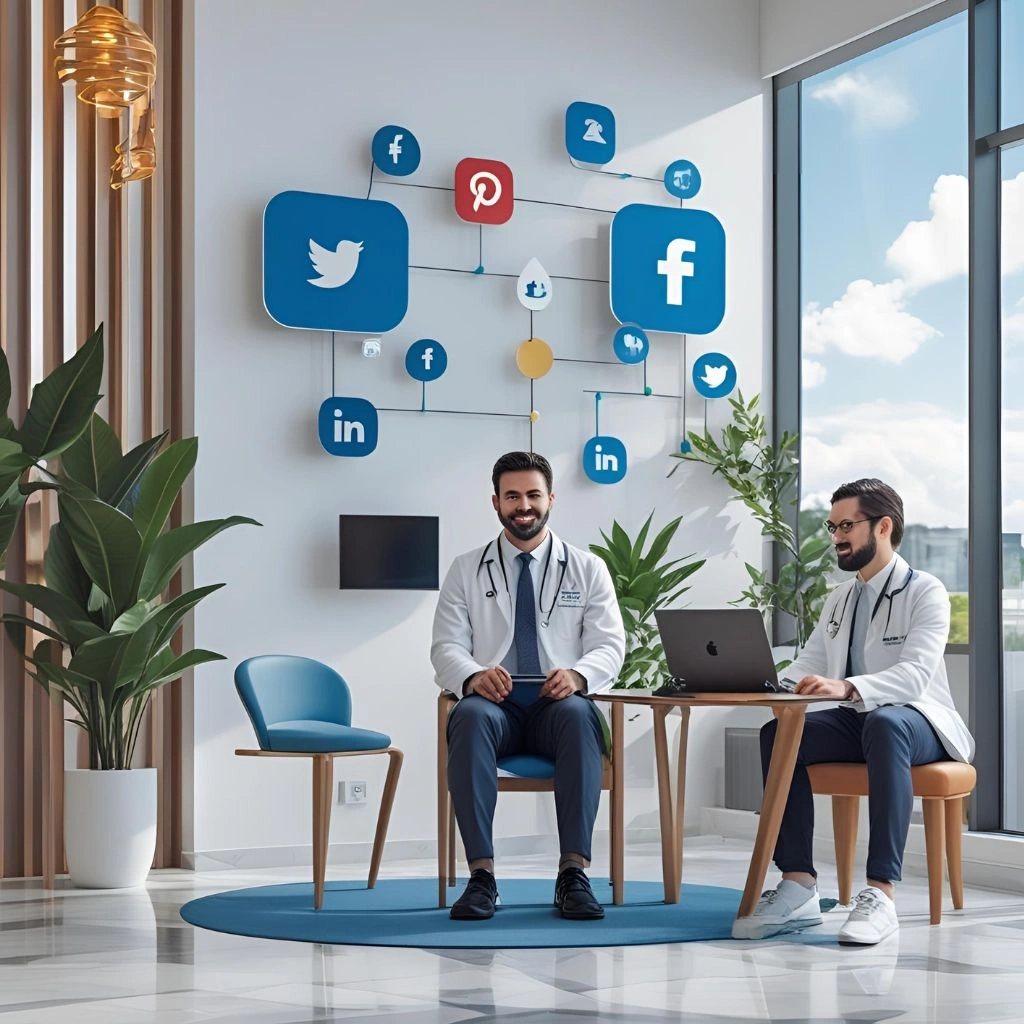
What is Digital Transformation in Healthcare?
Healthcare digitalization is the application of technology to digitalize, automate, and streamline processes, workflows, and services within the healthcare ecosystem. This is not merely about switching paper to computers—it’s about reinventing the way care is provided with connected, intelligent, and predictive systems.
Major Elements of Healthcare Digitalization:
- EHR Systems: Reducing paperwork with electronic records for convenient access to data.
- Telehealth Platforms: Facilitating remote consultations through video or mobile applications.
- Remote Patient Monitoring (RPM): Monitoring vitals in real-time using wearable devices.
- Clinic Management Software: Streamlining appointments, billing, diagnostics, and patient tracking.
- AI, Big Data, IoT, Blockchain: Enabling better decision-making, secure sharing, and predictive care.
Why Digital Transformation is Important?
Digital technology makes clinics quicker, safer, and more patient-centric. With Sehat Pro, for instance, small practices are able to keep up with big hospitals through automation, reporting, and patient engagement—all on one intelligent platform.
Advantages of Digital Healthcare
1. Enhanced Clinical Outcomes
- Access to records in real-time enables quicker, evidence-based decisions.
- AI-powered diagnosis provides better detection of diseases at early stages.
- Predictive analytics reduces unplanned emergency admissions by detecting health risks sooner.
2. Operational Efficiency
- Automated tools eliminate manual mistakes and administrative burden.
- Smart scheduling and digital inventory systems save time and personnel resources.
- Physicians spend more time with patients and less time on paperwork.
3. Patient Engagement & Empowerment
- Patients view health records, medication reminders, and schedules.
- Mobile apps enable ongoing interaction and active wellness monitoring.
- Educated patients become more invested in self-management of their health.
4. Reduced Costs and Increased ROI
- Electronic claims and billing shorten payment cycles and rejections.
- Remote treatment reduces in-office visits, saving time and overhead.
- Preventive care reduces long-term treatment and hospitalization expenses.
5. Informed Decision-Making
- Big data analysis identifies trends in patient conditions.
- Real-time dashboards facilitate resource planning and staff scheduling.
- Data aids in readmission prediction and chronic care management.
6. Broader Care Access
- Telemedicine narrows the gap for rural or underinsured patients.
- Multilingual mobile apps increase healthcare accessibility.
- Physicians can consult patients over distances with little wait time.
7. Compliance and Security of Data
- Electronic systems provide compliance with healthcare regulations such as HIPAA.
- Notifications prevent protocol violations or issues with consent.
- Audit logs and secure storage foster patient trust.
8. Scalability and Future Readiness
- Cloud-based platforms enable simple scaling for new services or patients.
- New departments or services can be introduced by clinics without disruption.
- Future tech integrations are easily enabled by smart infrastructure.
Key Technologies Powering Healthcare Digitalization
Electronic Health Records (EHRs)
- Unified, digital storage of medical history, lab results, and medications.
- Enhances coordination among multiple providers and departments.
- Reduces duplicate testing and monitors chronic illness.
Telemedicine Solutions
- Facilitates online consultations, digital prescriptions, and remote follow-ups.
- Perfect for routine checkups, chronic care, and post-op monitoring.
- Reduces wait times and increases patient convenience.
Remote Monitoring Devices
- Monitor patient vitals such as blood pressure, heart rate, and oxygen saturation.
- Applied in diabetes management, cardiovascular conditions, and geriatric care.
- Facilitates early warning of complications and hospitalizations.
Artificial Intelligence (AI)
- Drives diagnostic equipment, virtual assistants, and image analysis software.
- Learns to perform routine tasks such as billing and data entry.
- Tells disease risk and enhances clinical precision.
Cloud-Based Systems
- Facilitates secure access to records and tools remotely.
- Reduces infrastructure costs and aids disaster recovery.
- Enables real-time data sharing among care teams.
Blockchain Technology
- Guarantees safe sharing of data among hospitals, labs, and insurers.
- Facilitates transparency in billing, records, and clinical trials.
- Reduces fraud in pharmaceutical supply chains.
Internet of Medical Things (IoMT)
- Interconnects devices such as monitors, pumps, and trackers on a single platform.
- Enables real-time intervention on abnormal vitals.
- Improves treatment customization and response time.
Robotic Process Automation (RPA)
- Automates back-office operations such as claims handling and reporting.
- Reduces delays and human error in administration.
- Allows personnel to prioritize care over paperwork.
Future-Ready Trends in Digital Healthcare
Predictive and Preventive Healthcare
- AI detects health risks prior to symptoms appearance.
- Personalized regimens minimize unnecessary treatments.
- Wearables and mobile apps enable continuous wellness monitoring.
Digital Twin Technology
- Develops virtual patient models for testing treatments.
- Ideal for surgical planning and disease progression modeling.
- Enhances precision medicine and clinical safety.
AR/VR in Medical Use
- Virtual Reality assists in training surgeons without actual patients.
- AR visualizes anatomy for diagnostics and education.
- VR also enables mental health and chronic pain therapy.
Wearable Ecosystem Expansion
- Smartwatches, patches, and biosensors monitor 24/7 health.
- Feeds real-time into clinical systems.
- Decreases emergency admissions and enhances long-term care.
Unified Digital Health Platforms
- Centers EHR, imaging, billing, and lab data.
- Streamlines workflow between departments and locations.
- Provides a unified patient experience with zero silos.
Conversational AI & Voice Assistants
- Smart bots handle appointments and simple triage.
- Voice AI helps physicians with note-taking and testing.
- Decreases front-desk burden and enhances response times.
Cybersecurity and Compliance
- Greater security through multi-factor authentication and endpoint protection.
- System integrity maintained by regular audits.
- Cyber hygiene becomes an integral aspect of health IT operations.
Consumer-Centric, Outcome-Based Care Models
- Payment models change toward value-based measures.
- Digital experience and satisfaction drive provider success.
- Technology enables tailored, measurable, and timely delivery of care.
Final Thoughts
Digital disruption is no longer something to be anticipated for the future; it’s here and redefining all aspects of healthcare delivery. Clinics, physicians, and medical providers are now required to embrace intelligent solutions such as Sehat Pro to remain competitive, provide improved care, and operate more effectively.
By adopting technologies such as EHRs, telemedicine, AI, and cloud technology, clinics not only better serve patients but also future-proof the practice. Sehat Pro is built with this objective in mind—to enable healthcare providers with automation, insights, and tools that propel intelligent outcomes.
Frequently Asked Questions (FAQ)
Digital transformation in healthcare means using technology to improve patient care, clinic operations, and medical outcomes. It helps clinics become more efficient, accessible, and accurate by automating processes and offering remote services.
Sehat Pro simplifies appointment bookings, billing, and patient record management. It reduces paperwork, minimizes errors, and allows clinic staff to focus more on patient care instead of time-consuming manual tasks.
Yes, Sehat Pro is designed to be scalable. Small clinics and solo doctors can benefit from its user-friendly dashboard, automated tools, and low maintenance needs without requiring large investments or technical teams.
Absolutely. Sehat Pro includes telehealth features that allow doctors to consult patients via video calls, share prescriptions digitally, and monitor patients remotely—expanding your reach beyond physical clinic limitations.
Sehat Pro follows strict healthcare data security practices like encryption and access control. It ensures all patient data remains confidential, compliant with legal standards, and protected from unauthorized access or breaches.



